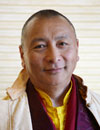
I think it would be good, Rinpoche said, to clarify something here about the three bodies of buddhahood or the trikaya. It’s said that all three bodies of buddhahood are permanent or lasting but in three different ways. The dharmakaya’s permanence lies in the fact that it is unborn; it never started. The sambhogakaya permanence consists of the fact that it is unceasing and the nirmanakaya’s permanence is the fact that it is continuous. The dharmakaya is what we otherwise refer to as emptiness, the nature of all things. The nature of all things, the nature of our minds is dharmakaya. And that nature, that dharmakaya, never started. It never began; whatever it is, it has always been.
Now, something that begins or starts must and will come to an end. Something that never begins or starts can never end.
The sambhogakaya — the body of complete enjoyment — is unceasing in its possession of five attributes that are called the “five certainties of the sambhogakaya.” And these are: certain body, the sambhogakaya itself; certain place, the highest pure realm; certain dharma, it always teaches the mahayana and vajrayana; a certain time, it is lasting until samsara is emptied or over; and certain entourage or retinue, the entourage or retinue of the sambhogakaya is always only bodhisattvas on the ten bhumis or levels.
The nirmanakaya’s permanence is in its continuity. The nirmanakaya is constantly reappearing in the form primarily of intentional rebirth. Now, the dharmakaya is what a buddha is. The sambhogakaya and nirmanakaya, which are referred to in our commentary collectively as the rupakaya, as the form bodies, are displays for the benefit of others. The reason for these displays is that wherever there is space, there are beings. Wherever there are beings, there are kleshas, mental afflictions. And wherever beings have mental afflictions, there are suffering.
We can actually trace the rupakayas or form bodies of a buddha back to their initial generation of bodhichitta when they first entered the path. They generate bodhichitta by saying, “I will achieve Buddhahood for the benefit of others.” Bodhichitta is unique among motivations in that it has a dual focus. The wisdom of bodhichitta is that it is focused on the achievement of perfect awakening. The compassion of bodhichitta is that it is focused on the benefiting, the liberation of all beings.
So, no one has ever achieved buddhahood for selfish reasons. No one has achieved buddhahood with the motivation “I will achieve budhdahood so that I can be a buddha.” The only way you can achieve buddhahood is with the motivation of wishing to help others by doing so. So therefore, when someone becomes a buddha, the dharmakaya automatically, naturally displays the sambhogakaya and nirmakaya.
[From a teaching on the Guru Yoga of Barway Dorje by Bardor Tulku Rinpoche. Translated by Lama Yeshe Gyamtso.]
